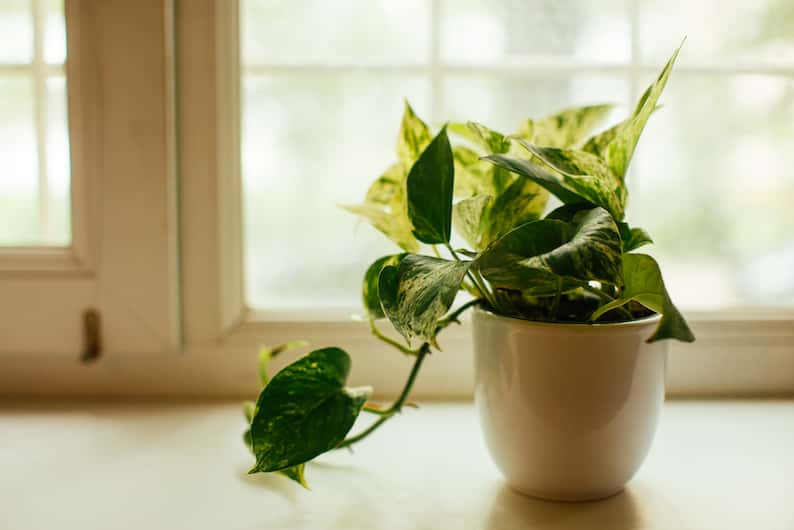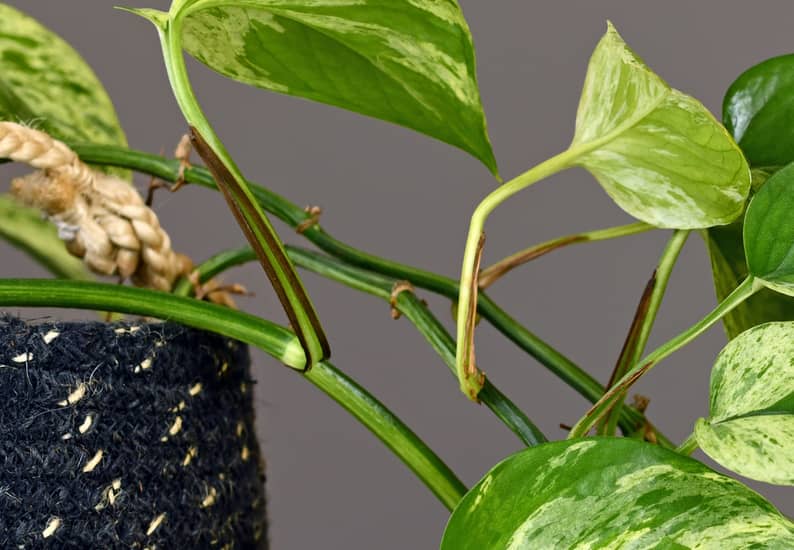If you’re not already familiar with them, pothos are a globally popular family of houseplants, loved for their vining stems and gorgeous, heart-shaped leaves.
Together with this, they’re low-maintenance and robust, making them ideal for beginners and green thumbs alike. Ultimately, their gratifying growth habits and die-hard attitudes make them a must-have in the home.
While there are dozens of varieties of pothos on the market, ranging from dark, shiny green to variegated types, much of their biological makeup is the same. They are all evergreen perennials that love a tropical environment, and they all have aerial roots and trailing stems. Another characteristic of interest is their prominent nodes, from which they sport new growth.
Indeed, in this article, we’ll explore everything there is to know about pothos nodes, from how to identify them to how to propagate stem cuttings. Ready? Let’s jump right in.

Table of Contents
What is a pothos node?
Pothos nodes are small bumps or knobs located on the stems of the plant from which its leaves grow. Pothos also have small, dark-colored nodes along their stems (and beneath each leaf) where they develop aerial roots, particularly during propagation.
Pothos plants have no shortage of nodes, which accounts for why they’re such prolific growers. In plant biology, nodes are built-up areas of tissues ripe with cellular and molecular activity. They look like little bumps or dots – but don’t be fooled by their discreet appearance. These minuscule nodules are playgrounds for growth.
Indeed, pothos have two primary types of nodes, namely leaf nodes and root nodes. The former is easy to identify by virtue of the fact that it usually comes with a leaf or branch multiplication and is identifiable by its knob-like appearance or a distinctive thickening of the stem.
The latter, root nodes, can be harder to spot, particularly on juvenile specimens. These look like tiny dark brown dots that slightly protrude from beneath each leaf and often all along the stem as well. Root nodes, as their name suggests, develop into aerial roots over time. And when propagating, they become the section of new growth you’ll eventually transfer into soil as a terrestrial (in-ground) rooting system.
You may also be interested in: Why Does My Pothos Have Brown Stems (and How to Fix It)?
Do pothos have nodes?
Pothos have nodes aplenty, which is why these plants usually have bushy growth habits and long, trailing vines that can adhere themselves to climbing poles or trellises via their aerial roots. Leaf nodes are responsible for their abundant foliage, and root nodes serve the dual purpose of sporting new growth and drawing in moisture and oxygen from the air.
Nodes are also crucial in the propagation process, as healthy nodules are necessary for stem cuttings to form new growth. A stem without any visible or developed nodes will have nowhere to spring new roots. They’ll also be unable to draw in nutrients from the water, soil, or air.

How do you find a node on a pothos?
To locate root nodes, the first place to look is directly beneath each leaf, where you’ll see a tiny, dark brown projection or dot. They are also present at short distances from one another all along each healthy stem.
Pothos nodes are easy to identify by sight or feel. Leaf nodules are clear to spot, as they are simply the thickening of the stem where leaves are growing. Once you know how to spot a pothos node, you’ll never not see them.
And if you’re looking to propagate your pothos, they’ll become essential to identifying healthy stem cuttings ripe for turning into new juvenile plants. Indeed, there is no hard science to spotting nodes – you just need to know what you’re looking for.
As mentioned, they’re easy to spot because they’re the parts of the stem that aren’t smooth or green. They look like small nodules or protrusions and can range in color from dark brown (when they are just developing) to light green (when they are busy growing into leaves or roots).
If your pothos plants are healthy, there is no feasible reason why they shouldn’t have visible, robust nodes. Even so, not all root nodes develop into aerial roots, and some will dry out, leaving only a slight thickening of the stem. However, this does not mean they are unsuitable for propagation. New roots can still form along any visible node if they have access to water and nutrients.
Related: How to Manage Pothos Aerial Roots: The Ultimate Guide
Can you grow pothos from just a node?
Pothos plants can be propagated from stems without any leaves, provided they have nodes that are submerged in water or soil. It’s not ideal, as leaves are essential to drawing in sunlight energy and moisture from the air, but it is possible with proper care and propagation processes.
Don’t be disheartened if you’re dealing with a less leafy baby or if you’re trying to propagate a pothos stem without any leaves. These hardy plants are surprisingly resilient, and stem cuttings can sport new growth even if they only have a few visible nodes.
Indeed, in a perfect world, all our stem cuttings would have two to three large, healthy leaves and a multitude of vigorous nodes, but this is not always the case. In fact, I like to try and propagate post-pruning, which means my stems are sometimes completely without leaves or shorter than I would like.
If this is the case, there are a few additional measures you can put in place to try and ensure successful propagation. Key to this is providing as much supplementary environmental support as possible in the form of humidity and moisture, which we’ll get into in greater detail in the following sections.
You may also be interested in: Do Pothos Like Humidity? (6 Tips to Boost It)
Can you propagate a pothos node without a leaf?
It is possible to propagate leafless stem cuttings, although more work will be needed as it won’t have leaves to absorb sunlight for photosynthesis. You will need to compensate for its loss of energy with additional humidity and moisture until such a time that it can develop new leaves.
That is, you’ll need to understand a little about how the biological processes of your plants work. In their growing environments, roots draw in moisture and nutrients from the air, water, and soil, which are converted into growth through photosynthesis, which requires energy from sunlight.
Without sunlight, this process can become more arduous for your plant. Leafless propagation has a slower success rate than regular propagation, but it is nonetheless possible in ideal growing conditions.
Related: What Are Your Pothos Light Needs (So Your Plant Can Thrive)?
Can you propagate pothos without a node?
No, you cannot propagate pothos without a node. This is because, without a node on your cutting, there is nowhere for new growth to develop. That said, it’s unlikely that you’ll find a cutting completely devoid of nodes, as they are relatively prevalent, appearing every few inches.
Nodes on a pothos are full of powerful cells and molecules that develop into roots and leaves when they have access to nutrients, minerals, oxygen, and water. Stems without nodes lack this cellular makeup and will not produce roots despite your best efforts.
When taking stem cuttings from your existing pothos, it’s vital you ensure there are at least a few nodes visible to give them their best chance at growth.

How do you propagate pothos nodes?
The most crucial part of propagating pothos nodes is ensuring access to plenty of moisture and humidity. If you are propagating a stem cutting without any leaves, you can opt to submerge the nodes in water or to lay the cutting on a damp growing medium in a warm, sunny growing environment.
Covering the cutting will also allow it to retain and draw in humidity.
If, like me, you can’t bear to throw away even the smallest bits after pruning your pothos, you’re in luck. While not consistently successful, it’s possible to propagate juvenile pothos from leafless stems with nodes, albeit with a bit of patience and lots of regular care.
I employ two methods to give my pothos cuttings their best chance of growth. The first is to dip the cutting into growth hormone (for an extra boost) and then to submerge it directly into a jar of water. Or, if I’m feeling brave, into a planter with prepared soil. In both cases, I always make sure to keep the cutting in the sunniest spot I can find so that it has access to plenty of humidity and as much solar energy as possible, to make up the deficit it would usually receive from its leaves.
Related: 5 Easy Steps to Transfer a Propagated Pothos from Water to Soil
The second method is a little more labor-intensive, but I find it is often more successful. To start, I prepare a shallow dish or container with a damp growing medium of soil for pothos and peat moss, the latter of which is chockful of nutrients.
I then cover the container with a layer of cling film or a see-through lid before placing it in a warm, bright area. This way, the cutting thrives in the humidity caused by the evaporation of the damp growing medium’s exposure to heat.
For this process, I also mist my cuttings every few days as an additional boost and to lock in as much moisture and dampness as possible. As a proviso, the key is to mist and not drench – the cuttings should be lightly damp but not wet, as this will overwhelm them and make it difficult for them to produce new growth.
